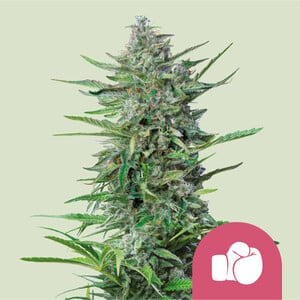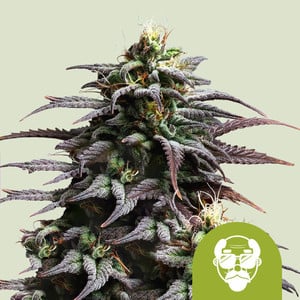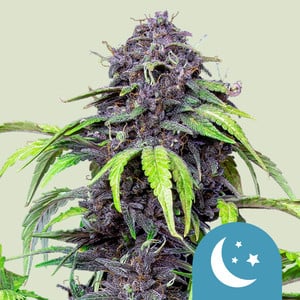Quetta XXL Purple‑23
élevé par Indian Landrace ExchangeIci vous pouvez trouver toutes les informations sur Quetta XXL Purple‑23 de Indian Landrace Exchange. Si vous recherchez des informations sur Quetta XXL Purple‑23 à partir de Indian Landrace Exchange, consultez notre : Informations de base, Galerie, Dégustation, Trophées, Recensions, Comparaisons Directes, Lignée / Généalogie, Hybrides / Croisés, Commentaires de l'utilisateur, pour cette variété de cannabis ici sur cette page et suivez les liens pour obtenir encore plus d'informations. Si vous avez des expériences personnelles avec la culture ou la consommation de cette variété de cannabis, veuillez utiliser les télécharger des liens pour les télécharger dans la base de données!
Informations de base
Quetta XXL Purple‑23 is an indica from Indian Landrace Exchange et peut être cultivé indoors and outdoors (Là où les plantes auront besoin d'une période de floraison de ±84 jours) Indian Landrace Exchange Quetta XXL Purple‑23 n'est/n'a jamais été disponible en graines féminisées.
Description de Indian Landrace Exchange
Quetta 23 XXL Purple Selection from Quetta, Balochistan, Pakistan. A THC-dominant broad-leaf indica of strong diesel aromas.
It grows tall and robust, with heavy lateral branching, flowering in 11-13 weeks.
Its growing season typically spans from April to November. This hashplant indica produces dry resin and delivers a potent sedative body high.
Balochistan cannabis culture is legendary. Balochistan is the largest province in Pakistan situated at the southwest territories bordered by Afghanistan towards North and North West, Iran towards south west, Sindh in the East and Khyber Pakhtunkhwa/FATA regions in the North East. Farmers in Balochistan have a much more open mindset regarding the use of agricultural practices to enhance their crops.
For years, the Indian Landrace Exchange has been showcasing different selections from Balochistan. This year, they have once again focused on the desert region of Dasht, which is essentially a series of mountains, slopes, and remote valleys on the outskirts of Quetta. This particular region on the outskirts of Quetta is extremely dry and experiences a desert climate with minimal rainfall during the hottest months of the year. Almost all precipitation falls in the form of snow during winter. The temperature remains cool almost all year round in the mountains, with snowfall occurring between early November and early December.
Balochistan is located at around 30ºN of the equator with no extreme altitudes (not exceeding 4000 meters), allowing the local varieties to exhibit characteristics typical of populations naturally adapted to mid-latitude ranges between approximately 24º-32ºN. These populations typically exhibit characteristics characterized by a medium to long flowering period of 11 to 13 weeks, including a stretching period of 3 to 4 weeks prior to actual flowering, tripling in size by the end of maturation.
Farmers in this area import fully domesticated cannabis varieties from higher latitude regions such as Afghanistan and Uzbekistan to crossbreed them with their native variety. This process aims to achieve more compact plants with shorter flowering times, boasting higher concentrations of cannabinoids and terpenes. As a result, they produce a hashish that is both more flavorful and potent.
As is customary in traditional cannabis varieties for hashish production, populations are massively reproduced through open pollination using a large number of different parents. Consequently, a significant amount of genetic diversity can be found, primarily in terms of plant and flower structure. However, traits such as smell, high, colors, and flowering duration largely remain consistent among the plants.
The Indian Landrace Exchange chose to collaborate with one of the most experienced cultivators in this region, renowned for their beautiful purple/red-hued plants and their production of potent hashish. With the assistance of this local cultivator, the Indian Landrace Exchange conducted beautiful selections of purple phenotype from their fields, emphasizing the complete genetic diversity of their crops. They offered various types of purple-colored plants from this native variety.
Critiques sur Quetta XXL Purple‑23
Dégustation de Quetta XXL Purple‑23
Effet/Efficacité
Odeur / Arôme
Goût
Galerie Quetta XXL Purple‑23
Aucune image n’a été téléchargée jusqu’à présent. Cliquez sur here pour en ajouter.Comparaisons Quetta XXL Purple‑23
Comment pousse et agit Quetta XXL Purple‑23 comparé à d'autres variétés ? 0 utilisateurs de Seedfinder ont téléchargé des comparaisons directes avec la variété Quetta XXL Purple‑23 de Indian Landrace Exchange et l'ont comparée à 0 autres variétés de cannabis.
Indian Landrace Exchange Quetta XXL Purple‑23:Quetta XXL Purple‑23 Lignée / Généalogie
Hybrides & Croisements avec Quetta XXL Purple‑23
Nous avons trouvé 0 descendants directs de Indian Landrace Exchange dans la base de données de seedfinder.eu, ici un bref aperçu. Pour voir tous les hybrides et leurs descendants, visitez notre Page Généalogie de Quetta XXL Purple‑23 et découvrez tous les descendants directs, les croisements comme ceux des générations suivantes.
Quetta XXL Purple‑23 Commentaires des utilisateurs
Ensemble, nous avons recueilli 0 à propos de Indian Landrace Exchange.Malheureusement aucun de ces commentaires n'est en fr !
Envoyez votre info sur cette variété ici:
Savez-vous quelque chose de plus sur Indian Landrace Exchange? Aidez s'il vous plaît à améliorer cette base de données et téléchargez / connectez vos informations ici!
Photos
Les images parlent plus que les mots ! Téléchargez vos photos "Quetta XXL Purple‑23" ici et aidez les autres producteurs à avoir une meilleure impression de cette variété.Comparaisons
Quetta XXL Purple‑23 VS. Formulaire de comparaison directe des déformationsRecension de Variété
Nos critiques de variétés sont multilingues, consultables et peuvent être très détaillées - y compris des données sur la culture, l'arôme, les effets et le goût ! S'il vous plaît téléchargez votre avis Quetta XXL Purple‑23 ici pour aider les autres utilisateurs de Seedfinder !
Valeurs Pharmaceutiques
Avez-vous de l'expérience avec les qualités médicales de Quetta XXL Purple‑23 ? Partager vos informations ici peut peut-être aider d'autres personnes !
Sujets
Vous êtes tombé sur une discussion liée à Quetta XXL Purple‑23 dans un forum ou une communauté de producteurs ? Connectez-le ici et permettez aux autres utilisateurs de trouver ces informations rapidement et facilement !
Vidéos
Vous avez trouvé une vidéo connexe contenant des informations supplémentaires ou des informations sur la croissance de Quetta XXL Purple‑23 sur YouTube ? Veuillez le connecter ici à la page d'informations sur la variété !





